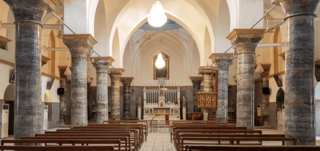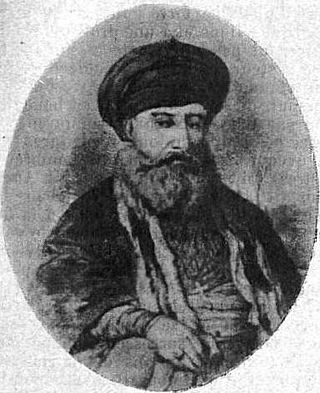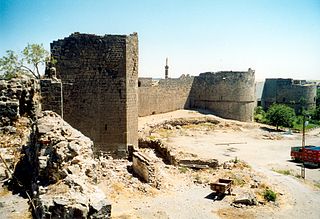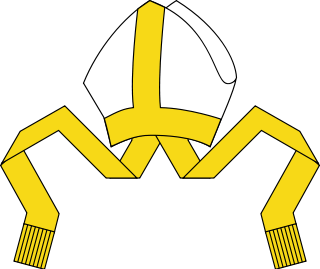Related Research Articles

Alqosh is a town in the Nineveh Plains of northern Iraq, a sub-district of the Tel Kaif District situated 45 km north of the city of Mosul.

The Chaldean Catholic Church is an Eastern Catholic particular church in full communion with the Holy See and the rest of the Catholic Church, and is headed by the Chaldean Patriarchate. Employing in its liturgy the East Syriac Rite in the Syriac dialect of the Aramaic language, it is part of Syriac Christianity. Headquartered in the Cathedral of Our Lady of Sorrows, Baghdad, Iraq, since 1950, it is headed by the Catholicos-Patriarch Louis Raphaël I Sako. In 2010, it had a membership of 490,371, of whom 310,235 (63.27%) lived in the Middle East.

Catholics in Iraq follow several different rites, but in 2022, most (82%) are members of the Chaldean Catholic Church; about 17% belong to the Syriac Catholic Church, and the remainder are primarily Armenian, Greek and Latin-rite Catholics.

Mar George Garmo was the Archbishop of the Chaldean Catholic Archeparchy of Mosul in Iraq from 14 September 1980 until his death on 9 September 1999.
Paulos Faraj Rahho was a Chaldean Catholic prelate who served as the Archeparch of Mosul in the northern part of Iraq from 2001 until his death in 2008 at the hands of terrorists.
Mar Yousef VII Ghanima was the patriarch of the Chaldean Catholic Church from 1947 until his death in 1958.

Yohannan VIII Hormizd (1760–1838) was the last hereditary patriarch of the Eliya line of the Church of the East and the first patriarch of a united Chaldean Church. After the death of his uncle Eliya XI in 1778, he claimed the patriarchal throne in 1780 and made a Catholic profession of faith. In 1783, he was recognized by the Vatican as patriarchal administrator and archbishop of Mosul. His career as patriarchal administrator was controversial, and was marked by a series of conflicts with his own bishops and also with the Vatican. Suspended from his functions in 1812 and again in 1818, he was reinstated by the Vatican in 1828. In 1830, following the death of the Amid patriarchal administrator Augustine Hindi, he was recognised by the Vatican as patriarch of Babylon of the Chaldeans and the Mosul and Amid patriarchates were united under his leadership. This event marked the birth of the since unbroken patriarchal line of the Chaldean Catholic Church. Yohannan Hormizd died in 1838 and his successor Nicholas I Zayʿa was chosen by the Vatican, ending the centuries-old practice of hereditary succession.
For much of the nineteenth and twentieth centuries the district of Salmas in northwest Iran was an archdiocese of the Chaldean Catholic Church, now a part of the Chaldean Catholic Archeparchy of Urmyā.

Dioceses of the Church of the East after 1552 were dioceses of the Church of the East and its subsequent branches, both traditionalist and pro-Catholic.

Chaldean Catholic Eparchy of Amadiya was a historical eparchy (diocese) of the Chaldean Catholic Church, until it was united with the Chaldean Catholic Eparchy of Zakho in 2013.
Aqra, properly ʿAqra, was a diocese of the Chaldean Catholic Church founded in the mid-19th century. It was united with the Archeparchy of Mossul to create the Archeparchy of Mossul-Aqra on December 22, 2018.

Chaldean Catholic Eparchy of Seert was a diocese of the Chaldean Catholic Church, centered in Seert. It existed during the eighteenth, nineteenth and early-twentieth centuries. The diocese was ruined during the First World War.

The Diocese of Amid (Diyarbakir) was a diocese or archdiocese of the Chaldean Church from the sixteenth to the twentieth century. From at least the 13th century the city of Amid had been part of the Diocese of Maiperqat of the Church of the East; following the schism of 1552 it became the seat of its own diocese in the Chaldean Church.
The Chaldean Catholic Archeparchy of Kirkuk is an archeparchy of the Chaldean Catholic Church in communion with the Pope in Rome. The archeparchy was created in the early years of the nineteenth century. Its present ordinary, Archbishop Yousif Thomas Mirkis, was consecrated in 2014.
Emil Shimoun Nona is the Archbishop of the Chaldean Catholic Diocese of Australia and New Zealand, prior to this he has been the Chaldean Catholic Archbishop of Mosul in the northern part of Iraq since the consent of Pope Benedict XVI to his election on 13 November 2009. He took over the archeparchy after the murder of Paulos Faraj Rahho in early 2008.
The Syriac Catholic Church, established in the second half of the 17th century as an Eastern Catholic offshoot of the Syriac Orthodox Church, had around a dozen dioceses in the eastern provinces of the Ottoman Empire in the 18th and 19th centuries. Three of these dioceses were ruined during the First World War in the Assyrian and Armenian massacres, and the 20th century also saw the growth of an important Syriac Catholic diaspora in America, Europe and Australasia. As of 2012 the Syriac Catholic Church has fifteen dioceses, mostly in the Middle East, and four patriarchal vicariates for the diaspora communities.

Ibrahim Namo Ibrahim is a bishop of the Catholic Church in the United States. He served as the Apostolic Exarch of United States of America from 1982 to 1985, and then, following its elevation, as the first eparch (bishop) of the Chaldean Catholic Eparchy of Saint Thomas the Apostle of Detroit, from 1985 until his retirement in 2014. Bishop Francis Y. Kalabat was named to succeed him as Eparch.

The Chaldean Catholic Archeparchy of Basra is a non-metropolitan Archeparchy of the Chaldean Catholic Church in southern Iraq.
Mart Meskinta Church, also known as Mart Meskanta, Mart Miskinta, Mart Meskanta, and Saint Meskinta Chaldean Church, is a historic Chaldean Catholic church located in Mosul, Iraq. The church dates originally from the twelfth century but underwent a significant renovation in 1851. It experienced damage in 2008 due to the Iraq War and in 2014-2017 due to the war against the Islamic State (ISIS).
References
- ↑ CNS Story: Kidnappers take Iraqi Archbishop, Kill his three companions Archived April 8, 2008, at the Library of Congress Web Archives
- ↑ "Kidnapped Iraqi archbishop dead", BBC News, 13 March 2008.
- ↑ "Rinunce e nomine".
